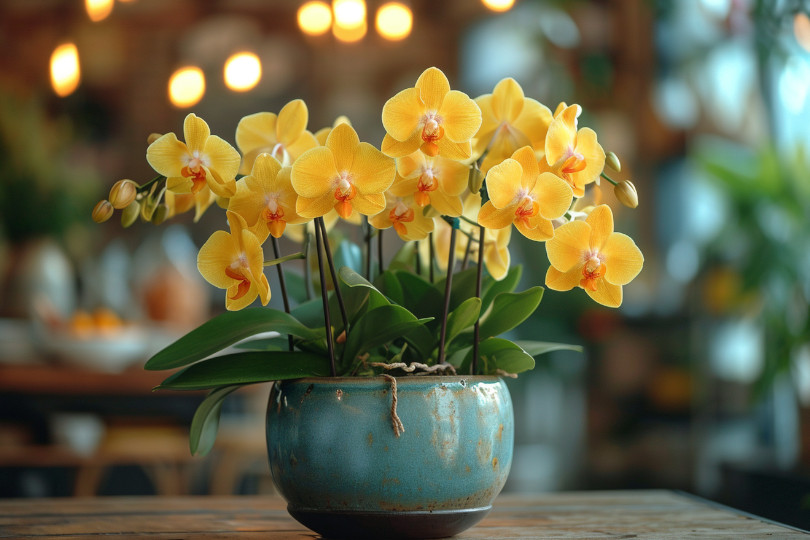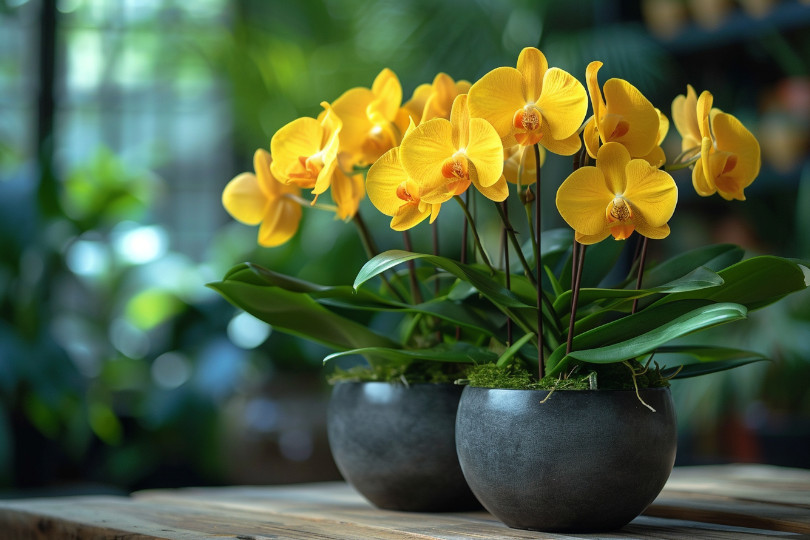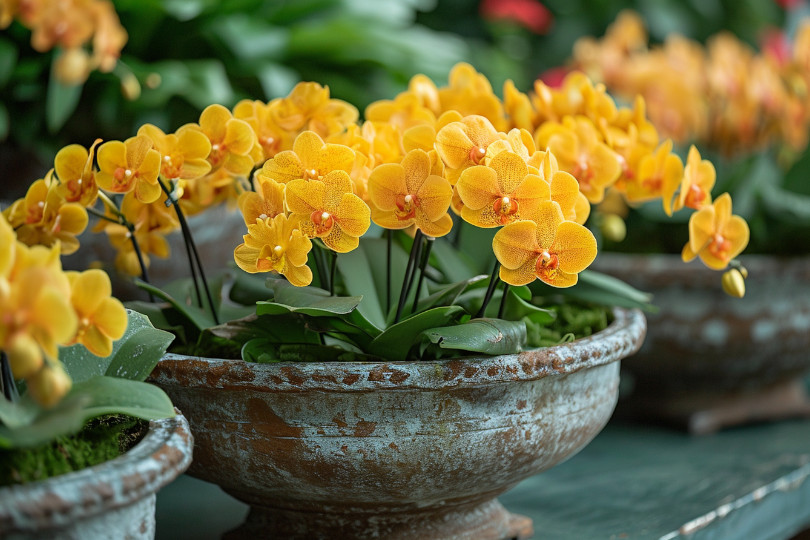Yellow orchids are a variety of orchids that feature stunning yellow blooms. Like other orchids, these flowers belong to the Orchidaceae family and are known for their intricate and elegant appearance. Yellow orchids come in various shades and variations of yellow, from pale lemon yellow to vibrant golden hues. They are typically characterized by their unique petal structure, with three outer petals and three inner petals forming a distinctive arrangement. These beautiful flowers are widely cultivated and highly sought-after for their beauty and charm. With their sunny and cheerful color, yellow orchids bring a vibrant touch to any space they adorn.
Table of Contents
Symbolism of Yellow Orchids
Yellow orchids are often associated with happiness, joy, and optimism. The vibrant yellow color of these flowers is reminiscent of the sun and can instantly uplift one’s mood. They symbolize positive energy and bring a sense of cheerfulness to any space. Yellow orchids are also considered a symbol of friendship and new beginnings. Giving someone a yellow orchid can be a gesture of friendship, showing that you value their presence. Additionally, yellow orchids are believed to bring good luck and prosperity. These beautiful flowers symbolize positivity and new opportunities, making them a perfect gift for special occasions or brightening someone’s day.
5 Popular Varieties of Yellow Orchids
Yellow orchids come in various stunning varieties, each with its unique characteristics. Here are five popular types of yellow orchids:
Cymbidium Orchids
Appearance: Cymbidium orchids are known for their striking, large flowers, which come in various colors, including rich yellows. These flowers often have contrasting lips, adding to their visual appeal.
Habitat: They are native to Asia and Australia and well-adapted to cooler climates than many other orchid types.
Care: These orchids require moderate temperatures and a good amount of light. They are relatively easy to care for, making them popular among beginners.
Oncidium Orchids
Appearance: Often referred to as the “Dancing Lady” orchid, Oncidiums boast delicate, fluttery blooms that resemble a skirt. Their yellow flowers are typically speckled or marked with brown or red.
Habitat: Originating from South and Central America, these orchids thrive in various climates.
Care: Oncidiums prefer high humidity and varying temperatures and need good air circulation.
Phalaenopsis
Appearance: Phalaenopsis, or “Moth Orchids,” are among the most popular orchids. Their blooms are broad and flat and come in many colors, including shades of yellow.
Habitat: These orchids are native to Asia and can thrive in a warm indoor environment.
Care: They are low-maintenance, requiring indirect light and minimal watering, making them ideal for indoor cultivation.
Dendrobium Orchids
Appearance: Dendrobiums offer a diverse range of colors, including bright yellows. Their flowers are often more elongated and grow along a central stem.
Habitat: With species found across Asia, these orchids can adapt to various environments.
Care: They require a good amount of light and a drop in temperature at night to thrive.
Paphiopedilum Orchids
Appearance: Known as “Slipper Orchids,” Paphiopedilums are unique for their pouch-like lip. The yellow varieties often feature mottled green or brown patterns.
Habitat: These orchids are native to the jungles of Southeast Asia.
Care: They prefer lower light conditions and consistent moisture, making them more challenging for casual growers.
Each of these yellow orchids brings unique beauty and requirements, offering something special for seasoned collectors and beginners in the world of orchid cultivation.
Caring for Yellow Orchids



Yellow orchids require specific care to thrive and flourish. Here are some essential tips for caring for yellow orchids:
Light and temperature requirements
Thriving in bright, indirect light, yellow orchids can be ideally placed near a window where they can receive filtered sunlight. Nevertheless, direct sunlight can be too intense and lead to burning of the leaves. As for temperature, yellow orchids prefer a range of 65 to 75 degrees Fahrenheit during the day. Nighttime temperatures can be slightly more relaxed, but they should still be within a comfortable range for the orchids. Extreme temperatures can stress the plant and hinder its growth. By providing the right amount of light and maintaining the appropriate temperature, you can create the perfect environment for your yellow orchids to flourish and showcase their vibrant blooms.
Watering and fertilizing tips
It is essential to water yellow orchids correctly to ensure their health. One general guideline is to water the orchid only when the top inch of the potting mix feels dry. Overwatering should be avoided as it may cause root rot. When watering, use room temperature water and thoroughly soak the potting mix, allowing any excess water to drain.
Fertilizing yellow orchids is also essential to provide them with the necessary nutrients. During the growing season, it is recommended to use a balanced orchid fertilizer and apply it every two to three weeks. Dilute the fertilizer to half or quarter strength before application.During the growing season, it is recommended to use a balanced orchid fertilizer and apply it every two to three weeks. Dilute the fertilizer to half or quarter strength before application. Reduce fertilizing frequency during the dormant period. Follow the package instructions and avoid overfertilizing, as it can damage the orchid’s roots.
Potting Mix and Repotting
Potting mix plays a key role in the health and growth of yellow orchids. It needs to be well-draining and provide ample aeration for the roots. A recommended potting mix for yellow orchids combines bark, sphagnum moss, perlite, and charcoal. This mix allows for proper drainage and prevents the roots from becoming waterlogged.
Yellow orchids should be repotted once every one to two years, or when the potting mix starts to deteriorate and get dense.. It’s best to repot in the spring after the blooming period. Remove the orchid from its old pot and carefully trim any dead or rotting roots. Place it in a slightly larger pot with fresh mix, ensuring the roots are spread out and not overcrowded. Remember to water the orchid thoroughly after repotting to help with its recovery.
Common Yellow Orchid Diseases and Pests
Yellow orchids can face common diseases and pests that affect their health and growth. Root rot is a prevalent problem that arises when the roots are persistently damp and do not have sufficient drainage. In such cases, the roots can become soft and turn black. Additionally, there may be instances of fungal infections, resulting in blemishes or discolouration on the leaves or flowers. Pests such as aphids and spider mites can infest yellow orchids, sucking the sap out of the plant and causing leaves to wilt and turn yellow. Regularly inspecting your orchids for signs of diseases and pests and taking necessary measures such as providing proper ventilation, removing infected parts, and using organic insecticides can help maintain the health of your yellow orchids.
Root rot and fungal infections in Yellow Orchids
Yellow orchids may encounter frequent occurrences of root rot and fungal infections. The roots become soft and black when they are constantly damp and inadequately drained, resulting in root rot. This can significantly damage the plant’s health and growth. Fungal infections can also affect yellow orchids, causing spots or discoloration on the leaves and flowers. To prevent these problems, it is essential to provide proper ventilation and ensure the orchids are not overwatered. If root rot or fungal infections are detected, removing the affected parts and using appropriate fungicides to control the spread is necessary. Regular inspection and proper care can help keep yellow orchids healthy and vibrant.
Aphids and spider mites
Yellow orchids can be affected by two types of pests that are commonly known as aphids and spider mites. These aphids are tiny insects that have soft bodies and feed on the sap of plants. This can lead to stunted growth and distorted leaves. Detecting spider mites can be a challenging task as they are minute pests, but they have the potential to cause yellowing of leaves and webbing on the plant. Controlling aphids and spider mites requires regular monitoring and early detection. Use insecticidal soap or neem oil to eliminate these pests. Maintaining a clean and pest-free growing environment for your yellow orchids is also essential by regularly removing dead leaves and debris.
Conclusion
In conclusion, yellow orchids are a beautiful and meaningful addition to any space. Their vibrant color symbolizes happiness, joy, friendship, and new beginnings. With their wide variety of species, including the popular Phalaenopsis and Oncidium, there is a yellow orchid to suit every taste. Caring for yellow orchids involves providing the right light and temperature conditions, watering and fertilizing appropriately, and repotting when necessary. Awareness of common diseases and pests such as root rot, fungal infections, aphids, and spider mites is also essential. Following proper care guidelines and promptly addressing any issues, you can enjoy the stunning beauty of yellow orchids in your home or garden.
Bringing the beauty of yellow orchids into your life
Bringing the beauty of yellow orchids into your life can be a truly transformative experience. These stunning flowers add vibrant color and elegance to any space, whether it’s your home, office, or garden. Placing yellow orchids in areas where you spend a lot of time can uplift your mood and create a positive atmosphere. Their joyful and vibrant aura can have a calming and rejuvenating effect on your emotions. Whether you display them as a centerpiece, in a hanging basket, or as part of a floral arrangement, yellow orchids will catch the eye and bring a touch of natural beauty into your daily life. Take advantage of the opportunity to enjoy yellow orchids’ unique and captivating presence.

